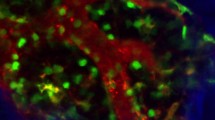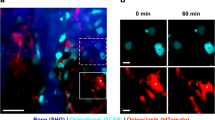Summary
The confocal laser scanning microscope (CLSM) enables the collection of images picturing selected planes in depth of thick samples, thus giving 3D information while keeping the sample intact. In this article we give an overview of our CLSM applications in bone research: (i) the characterization of osteoblasts and osteoclasts properties in cell biology, (ii) the visualization of the three dimensional (3D) osteocyte lacunar canalicular network in undemineralized plastic-embedded bone samples, (iii) the observation of tetracycline labels in bone biopsy samples from patients in combination with information on the mineralization density from quantitative backscatter electron imaging, which enables the time course of mineral accumulation in newly formed bone to be followed, (iv) the precise measurement of the thickness of thin ground bone sections, a prerequisite for the mapping of local mechanical properties by scanning acoustic microscopy.
Zusammenfassung
Das konfokale Laser-Scanning-Mikroskop (CLSM) ermöglicht die Serienaufnahme von Bildern auch aus tiefer gelegenen Schichten einer Probe und damit 3‑D-Informationen, ohne dabei die Probe zu zerstören. Im vorliegenden Artikel geben die Autoren einen Überblick über ihre Anwendungen des CLSM in der Knochenforschung: (i) die Charakterisierung von Eigenschaften der Osteoblasten und Osteoklasten in der Zellbiologie; (ii) die dreidimensionale (3-D-)Darstellung und Vermessung des Osteozytenlakunen-Canaliculi-Netzwerks von in Kunststoff eingebetteten nichtdemineralisierten Knochenproben; (iii) die Identifikation von Tetrazyklinmarkierungen in Knochenbiopsien von Patienten, die – in Kombination mit Informationen über die lokale Kalziumkonzentration aus quantitativer Rückstreuelektronenmikroskopie – Rückschlüsse über den zeitabhängigen Anstieg der Kalziumkonzentration in neu angebautem Knochen erlaubt; (iv) die präzise Messung der Dicke von Knochendünnschliffen. Letztere Information ist die Voraussetzung für die Ermittlung bestimmter lokaler mechanischer Eigenschaften mit Ultraschallmikroskopie.








Similar content being viewed by others
References
Bidan CM, Kollmannsberger P, Gering V, Ehrig S, Joly P, Petersen A, Vogel V, Fratzl P, Dunlop JW. Gradual conversion of cellular stress patterns into pre-stressed matrix architecture during in vitro tissue growth. J R Soc Interface. 2016; https://doi.org/10.1098/rsif.2016.0136.
Blouin S, Puchegger S, Roschger A, Berzlanovich A, Fratzl P, Klaushofer K, Roschger P. Mapping dynamical mechanical properties of osteonal bone by scanning acoustic microscopy in time-of-flight mode. Microsc Microanal. 2014;20(3):924–36.
Bonewald LF. The amazing osteocyte. J Bone Miner Res. 2011;26(2):229–38.
Cappariello A, Maurizi A, Veeriah V, Teti A. The Great Beauty of the osteoclast. Arch Biochem Biophys. 2014;558:70–8.
Dallas SL, Veno PA. Live imaging of bone cell and organ cultures. Methods Mol Biol. 2012;816:425–57.
Hassler N, Roschger A, Gamsjaeger S, Kramer I, Lueger S, van Lierop A, Roschger P, Klaushofer K, Paschalis EP, Kneissel M, Papapoulos S. Sclerostin deficiency is linked to altered bone composition. J Bone Miner Res. 2014;29(10):2144–51.
Karsenty G. Update on the biology of osteocalcin. Endocr Pract. 2017;23(10):1270–4.
Luegmayr E, Glantschnig H, Varga F, Klaushofer K. The organization of adherens junctions in mouse osteoblast-like cells (MC3T3-E1) and their modulation by triiodothyronine and 1,25-dihydroxyvitamin D3. Histochem Cell Biol. 2000;113(6):467–78.
Luegmayr E, Varga F, Frank T, Roschger P, Klaushofer K. Effects of triiodothyronine on morphology, growth behavior, and the actin cytoskeleton in mouse osteoblastic cells (MC3T3-E1). Bone. 1996;18(6):591–9.
Luegmayr E, Varga F, Glantschnig H, Fratzl-Zelman N, Rumpler M, Ellinger A, Klaushofer K. 1,25-Dihydroxy vitamin D3 and tri-iodothyronine stimulate the expression of a protein immunologically related to osteocalcin. J Histochem Cytochem. 1998;46(4):477–86.
Minsky M. Memoir on inventing the confocal scanning microscope. Scanning. 1988;10(4):128–38.
Repp F, Kollmannsberger P, Roschger A, Berzlanovich A, Gruber GM, Roschger P, Wagermaier W, Weinkamer R. Coalignment of osteocyte canaliculi and collagen fibers in human osteonal bone. J Struct Biol. 2017a;199(3):177–86.
Repp F, Kollmannsberger P, Roschger A, Kerschnitzki M, Berzlanovich A, Gruber GM, Roschger P, Wagermaier W, Weinkamer R. Spatial heterogeneity in the canalicular density of the osteocyte network in human osteons. Bone Rep. 2017b;6:101–8.
Roschger P, Paschalis EP, Fratzl P, Klaushofer K. Bone mineralization density distribution in health and disease. Bone. 2008;42(3):456–66.
Rumpler M, Wurger T, Roschger P, Zwettler E, Sturmlechner I, Altmann P, Fratzl P, Rogers MJ, Klaushofer K. Osteoclasts on bone and dentin in vitro: mechanism of trail formation and comparison of resorption behavior. Calcif Tissue Int. 2013;93(6):526–39.
Varga F, Luegmayr E, Fratzl-Zelman N, Glantschnig H, Ellinger A, Prinz D, Rumpler M, Klaushofer K. Tri-iodothyronine inhibits multilayer formation of the osteoblastic cell line, MC3T3-E1, by promoting apoptosis. J Endocrinol. 1999;160(1):57–65.
Varga F, Rumpler M, Luegmayr E, Fratzl-Zelman N, Glantschnig H, Klaushofer K. Triiodothyronine, a regulator of osteoblastic differentiation: depression of histone H4, attenuation of c‑fos/c-jun, and induction of osteocalcin expression. Calcif Tissue Int. 1997;61(5):404–11.
Acknowledgements
This paper is dedicated to ao. Univ.-Prof. Dr. Adolf Ellinger, who—in his role as a consultant for microscopy—supported the strategic development plan for the foundation of the Ludwig Boltzmann Institute of Osteology (LBIO) in the late 1980s. It was his advice to acquire a CLSM as basic equipment for LBIO, at that time an innovative instrument. In the meantime, the CLSM has become a standard equipment for bone research and has been applied to a number of research questions in bone biology and material science by LBIO scientists.
The authors also thank their colleagues, in particular those who were engaged with development of the staining and imaging protocol at the outset of CLSM imaging at the LBIO.
Author information
Authors and Affiliations
Corresponding author
Ethics declarations
Conflict of interest
S. Blouin, A. Roschger, F. Varga, B. Misof, S. Spitzer, P. Roschger, and K. Klaushofer declare that they have no competing interests.
Additional information
This article is dedicated to Professor Ellinger who recognized early the potential of CLSM and encouraged our institute to purchase such a device. In the meantime, CLSM is used in a wide range of applications at the Ludwig Boltzmann Institute of Osteology.
Rights and permissions
About this article
Cite this article
Blouin, S., Roschger, A., Varga, F. et al. Confocal laser scanning microscopy—a powerful tool in bone research. Wien Med Wochenschr 168, 314–321 (2018). https://doi.org/10.1007/s10354-018-0639-x
Received:
Accepted:
Published:
Issue Date:
DOI: https://doi.org/10.1007/s10354-018-0639-x
Keywords
- Confocal laser scanning microscope
- 3D imaging
- Fluorochrome
- Osteoblast and osteoclast morphology
- Osteocyte lacunar canalicular network




